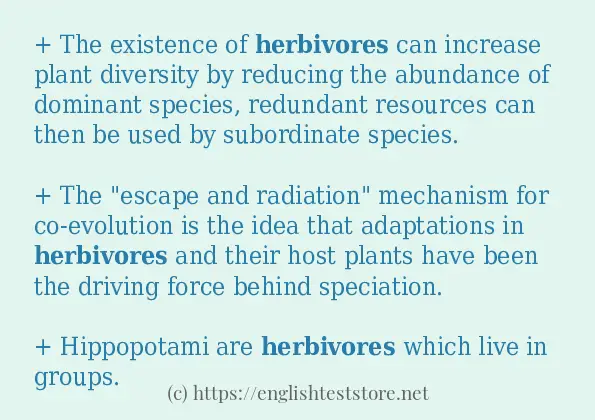How to use in-sentence of “herbivores”:
+ The existence of herbivores can increase plant diversity by reducing the abundance of dominant species, redundant resources can then be used by subordinate species.
+ The “escape and radiation” mechanism for co-evolution is the idea that adaptations in herbivores and their host plants have been the driving force behind speciation.
+ Hippopotami are herbivores which live in groups.
+ These are the trees which the large herbivores ate.
+ One way that plants could differ in their susceptibility to herbivores is through defense trade-off.
+ Especially large herbivores can enhance the bio-diversity by selectively excluding tall, dominant plant species, and increase light availability.
+ They are herbivores and are diurnal.
+ Huge numbers of herbivores migrate each year, followed by the big cats.

Example sentences of “herbivores”:
+ A few of the sea slugs are herbivores and some are carnivores.
+ Mean EQ for mammals is around 1, with carnivorans, cetaceans and primates above 1, and insectivorainsectivores and herbivores below.
+ A few of the sea slugs are herbivores and some are carnivores.
+ Mean EQ for mammals is around 1, with carnivorans, cetaceans and primates above 1, and insectivorainsectivores and herbivores below.
+ Due to the relatively lower level of proteins in grasses, which herbivores eat, cattle manure has a milder smell than the dung of carnivores–for example, elephant dung is practically odorless.
+ The red colour of leaves may camouflage leaves from herbivores blind to red wavelengths.
+ People used to think herbivores increase plant diversity by avoiding dominance.
+ Almost all large herbivores live in herds, which undoubtedly is safer than living alone.
+ Relationships between herbivores and their host plants often results in reciprocal evolutionary change, called co-evolution.
+ But herbivores could buffer the diversity reduction.
+ According to the theory of predator-prey interactions, the relationship between herbivores and plants is cyclic.Gotelli N.J.
+ These herbivores include the Ceratopsiaceratopsians.
+ They were the largest herbivores in their environment, and quickly reached.
+ The simplest gastropods are the limpets and abalones, both herbivores that use their hard radulas to rasp at seaweeds on rocks.
+ Body size of herbivores is a key reason underlying the interaction between herbivores and plant diversity, and the body size explains many of the phenomena connected to herbivore-plant interaction.
+ Small herbivores are less likely to decrease plant diversity.
+ They were the dominant herbivores of their time.
+ Biological control agents of weeds include herbivores and plant pathogens.
+ Generally, the existence of herbivores increases plant diversity.
+ All species of “Psittacosaurus” were gazelle-sized bipedal herbivores with a high, powerful beak on the upper jaw.
+ Musk oxen are herbivores which graze on grasses, leafleaves, and some Arctic flowers.
+ They may grow when herbivores are not around.
